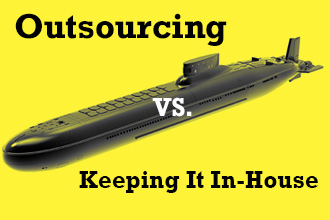Outsourcing vs. Keeping It In-House
 AV pros need to make the best use of their clients’ budgets. At the same time, AV pros need to make the best use of their own resources: time, money and expertise. One aspect of that resource management is weighing the decision to subcontract out some business functions. I’ve previously discussed choosing to subcontract programming, but what about other functions?
AV pros need to make the best use of their clients’ budgets. At the same time, AV pros need to make the best use of their own resources: time, money and expertise. One aspect of that resource management is weighing the decision to subcontract out some business functions. I’ve previously discussed choosing to subcontract programming, but what about other functions?
Should an AV firm subcontract or not? I’ve known dealers who’ve kept everything in-house, adding staff as their firm’s abilities balloon. I’ve also known dealers who’ve subcontracted most of their functions out to the point that they’re more accurately described as a project management consultant than an integrator, per se.
In the middle ground, it’s more common for AV pros to subcontract some of the things, some of the time.
The decision to subcontract out job functions can be broken down into asking whether it’s a more cost effective solution to hire outside help than to maintain it in-house. And it’s not always obvious. More than once it’s been the case that the general manager hires a programmer but actually needs a project manager.
Remember, the whole point of the exercise is to enhance efficiency and reduce costs. Choosing poorly does neither.
Those challenges lead some dealers to avoid using subcontractors. The main concern is often quality control, although other issues include the availability of a subcontractor to work on the their schedule. And if they do use a subcontractor, it may be on a special-case basis: One company I know “borrows” an installer from an alarm company in the same town, because he’s a genius at running lines in retrofit jobs. If they need the impossible accomplished, they call him. But it’s not an everyday occurrence.
It’s been my experience that companies that are more flexible about subcontracting are the ones who routinely execute ultra high-end projects. Overall, their own staff completes most of the work that they do, but will sub out specialty subsystems as required, such as acoustic treatment installation, electrical, security and telecom systems.
The reason for that is the conscious decision to focus on AV, the “wants” in a system, and not being weighed down by the “needs” like alarm and data. Since it’s better to be an expert at a few things rather than being a “Jack Of All Trades” it makes sense to sub out some functions that aren’t central to your core business.
Since an AV company is typically around 12 total staff members, you can’t be experts at everything. During the finishing stage of an installation there are always dozens of items that will need to be completed to put the final polish on a system: Items like phone or data lines into the rack, electrical outlets for the television and equipment locations or the assembly and installation of construction goods such as paneling and marquetry. Those are all situations where from a cost basis it may make sense to sub out those functions.
Some firms don’t subcontract their brainwork, design and programming, because their strengths, first and foremost are as a design company. That gives them their focus, and then they’re willing to sub out wire pulling and related install work. Generally, the reason firms sub out various job functions is when they do not have either enough work to keep payroll high or enough employees to handle the amount of work they expect.
Additionally, firms tend to rely on subcontracting when they feel that they lack the know-how to complete a project: A company that doesn’t know how to do something that is required for a particular job can always hire a freelancer to do it for them, on a per job basis.
So, what are the downsides? What happens when subcontracting doesn’t work, and how can it be fixed?
While the most obvious and biggest upside to using contractors for work is that the firm is not responsible for payroll when subcontractors are not utilized there are still downsides to the relationship.
With a staffed employee, the firm has control of their schedule. The project manager can say when and where employee needs to be working with very little chance of a scheduling conflict. Conversely, an outside contractor may change their schedule, sometimes at the last minute, and the firm may not be able to count on them when they’re needed.
The biggest danger in outsourcing is simply that the integrator stops integrating, and that means that the firm stops at being the center of the project. The more frequent the outsourcing becomes the less the involved the integrator is, and projects become less about what they actually know, and more about what external talent they can retain.
The risk here is that the clients notice these things, and AV pros who subcontract too heavily run the risk of being extraneous to future projects. If the client notices who the real pros are, the firm may be cut out of the loop for future work.
However, the biggest potential downside is quality control, and the potential for bad communication. One AV pro friend told me of an issue they had when subbing the wire pulling. The sub did not follow the design documents because they decided “the documentation was wrong.” The end result was a disaster: hundreds of network cable locations with no labeling, and wire drops at random all over the house. While that was the last time that sub was used, it still left the principal firm with a big mess to clean up.
The key to making it work is communication, which, as the saying goes, is a two way street, and both integrator and subcontractor need to keep the lines open, and communicate constantly on the project; that’s a cardinal ground rule that needs to be laid down immediately.
Both sides need to provide the other with system documentation that is complete, consistent, and comprehensive. Additionally, integrators need to give their subcontractors fair warning when it comes to everything from the initial proposal to later change. That alone can solve most difficulties with the primary/subcontractor relationship.
The overall takeaway should be subcontracting is another a tool in the toolbox; there are specific times to make use of it. However, because there are multiple pitfalls and risks that come with over-dependence on subcontractors, it can’t be seen as a constant, one-size fits all solution.





